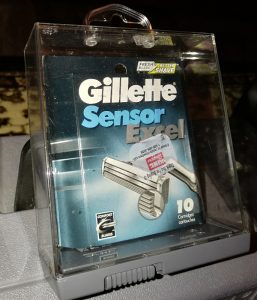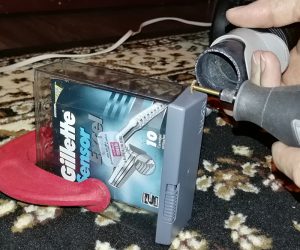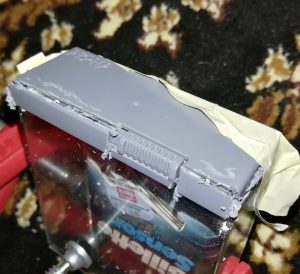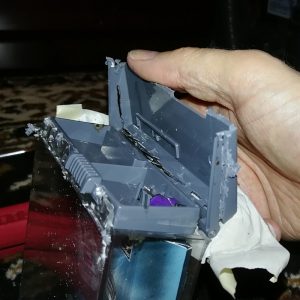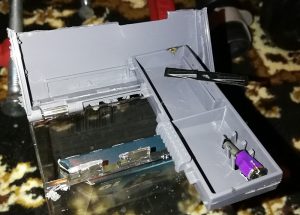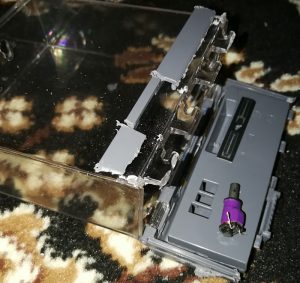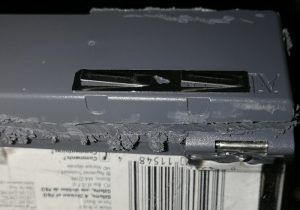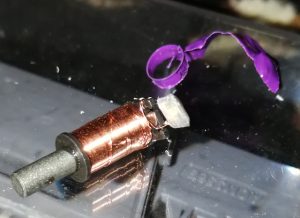I ran out to the store to grab some new razors, blew through self-checkout and when I got home later realized that I had the security boxes too. Usually people are stopped when leaving as they set off alarms but apparently this store’s alarms didn’t work. How am I going to get my razors out? Well, there’s always brute force but I thought I’d learn about these things instead.
At right is the receipt, this isn’t shoplifting and I paid for the “security packaging”, which is otherwise unlabeled. Usually they have “not for resale” or “to be returned to the store upon purchase” or something like that, but if it’s unlabeled it’s just packaging. Therefore, my property to do with as I please.
I cut around all four sides as I was expecting some sophisticated magnets and levers inside (due to all the rattling around), taping up what I’d finished so it wouldn’t spring apart.
Turns out I just needed to do the sides and the front, cutting on the vertices by the slide (as opposed to the front surface).
Once I opened it (the rear was still somewhat connected so it just opened on the hinge), I was struck at the simplicity (of course : has to be cost effective / cheap as possible!).
The security mechanism is a small piece of spring steel that sticks up a bit and catches on the lower tray to prevent it from sliding. The purple bit is an energizing coil to set off security sensors (more on that below). At this point it’s pretty straight forward : apply a strong enough magnet to a location on the top and the spring steel pulls in, allowing the tray to move.
This shows the orientation of the spring steel inside, right-side up. Inside of course it’s facing the other direction and the tray catches on those “fingers”, which would be pulled in by the strong magnet when applied to that location.
When applying magnets to the right location, this is the little “click” you hear – it’s lifting the entire piece of spring steel to the top of the box as well as the “fingers”, clearing the slide for the tray to move. It’s not sophisticated.
Here, a word about stacking magnets: if you take two identical magnets (from, say, the inside of a hard drive) then you can stack them which magnifies the magnetic field. Similar magnets from different drives (or even different locations from the same drive) don’t stack properly and can mess with the field.
In order to have a magnet strong enough, take apart two identical hard drives that have died and fish ’em out from there, or just order them online, they’re available as “strong neodymium Rare Earth Magnets” sold as a nice stack.
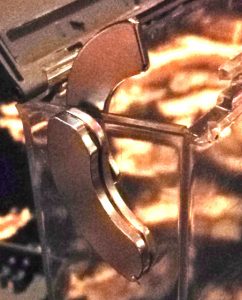
Below is a video that shows the magnetic effect – at the end of the video you’ll see the steel “fingers” slowly moving as they respond to the magnet on the other side. The magnet has to be long enough that the North/South polarity reaches both “fingers” and strong enough to pull them up past shear line through the plastic.
Now that I have it figured out, I can get out my other pack of razors! I can also keep the packaging as a reasonably tight storage container.
- Security has multiple layers, this is just one. There are still isle cameras and undercover store security. Even though you can open these boxes quickly you’d be surprised how quickly security cameras or people on the other end of the isle can see you doing it.
- It does change the “pocketing profile” (it’s harder to pocket the whole box than the smaller contents), but now you’ve moved something to your pocket which is easier for cams/people to see.
- Often goods inside these containers also contain magnetic foil that triggers the security alarm, you would need to remove both layers.
- Stores now have tracking technology that track your cellphone’s bluetooth and wireless MAC address throughout the store. They’re watching to see where you stop, what ads you stop in front of and other patterns, which highlight habitual shoplifters. If brought to trial (at this point it’s too late, you’re screwed, best to always be able to leave the store on your own two feet!) they’ll pull those logs as evidence such that they’ll match your phone to their data, then review the data to confirm your pattern. It’s possible that this data is shared across stores to reduce “shrink”.
- If one were to put the whole box in the cart and walk away, then fidget with it while you’re strolling later it’s harder for them to see, but now you have the item in your cart effectively doing the checkout staff’s job for them.
- Were you to do the above and go through self checkout, the weight sensors turn off when you start paying (via card: this is at the time when you’re supposed to insert your card), so most clerks won’t notice if you start to pay, move like you’re “scanning” one last item, put it in the bag, then push the ship card the rest of the way in. If you get caught by the monitor it’s easy to feign ignorance (“I was just paying and saw I forgot something, didn’t it ring up?” – who buys bags of groceries and then steals one thing?) For the above reasons though, this might work at that store once or twice on a different shift – after that a pattern is established and you’re nailed.


